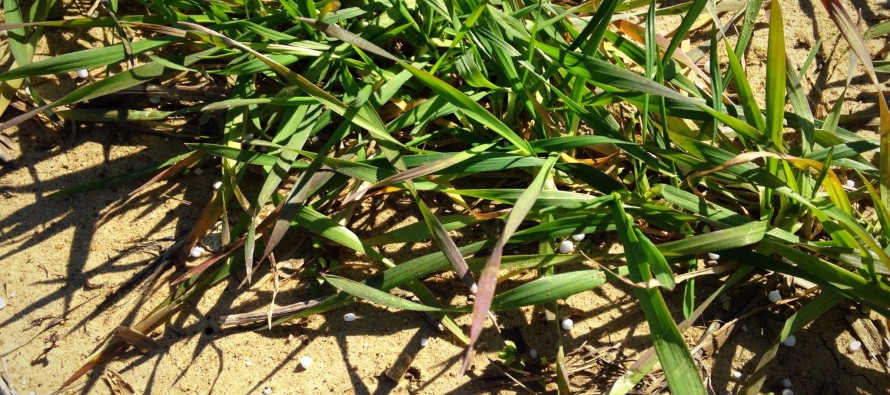2022 Nitrogen Fertilizer Recommendations for Wheat

Related Articles
- 2010 Soybean And Corn Variety Trial Data 3
- Fertilizing Cotton with Poultry Litter 5
- Spring Nitrogen Fertility Suggestions for Wheat 0
Latest Tweets
Our moist climate can challenge our ability to provide sufficient nitrogen fertility for growing productive wheat. Extremely high fertilizer prices only amplify our need and desire to manage this valuable input as efficiently as possible. Therefore, using best management practices are likely more important for wheat than any other crop, including corn. This is because wheat is grown during the wettest months of the year in our rainy, warm climate, which is normally very conducive to nitrogen loss. Therefore, nitrogen application timing is a critical factor affecting availability and potential nutrient loss. Optimal nitrogen timing can vary substantially because seasonal temperatures, planting date and variety all affect wheat development. Therefore, you can make better fertility decisions by closely monitoring wheat health and development, and evaluating the weather forecast, rather than relying on specific calendar dates and rate guidelines.
Although this publication focuses on nitrogen, don’t overlook other nutrients, as productivity will be reduced by whatever factor is most limiting. For instance, field areas where growth has lagged throughout the fall and winter could have other fertility issues, such as low soil pH, low phosphorus, etc…, which need to be addressed.
Key to success: Split-application methodology for nitrogen fertilizer is strongly recommended for wheat grown in our region. This strategy satisfies crop demand, while moderating potential nitrogen loss caused by denitrification in saturated soils common during the spring. This may be achieved through two or more split fertilizer applications with at least 2/3 of the total spring nitrogen applied after stem elongation begins. This strategy enhances the nitrogen available to support wheat productivity during the late spring.
Guidelines for split application: Only a small amount of nitrogen is necessary in the first spring topdress application (20-30 lbs. N/a.), because wheat nitrogen needs are quite modest, until stem elongation and rapid growth begins. This initial nitrogen topdress should be applied when prostrate, tillering stage wheat (Feekes growth stage 3 or 4) breaks winter dormancy and slowly resumes growth. This growth depends primarily upon warming temperatures, so closely monitoring the long term weather forecast, measuring soil temperature and assessing wheat growth in the field is more reliable than timing application according to calendar date. Wheat growth should resume when average daily air or soil temperature rises into the mid-40’s, or night temperatures approach 40 deg F. This will normally occur sometime in February depending on geography and seasonal temperatures. Neglecting wheat nutritional needs during this time may considerably limit the number of viable tillers that will produce heads and are essential to high wheat productivity. If a field has a thin stand, poor tillering due to late planting, or signs of nitrogen deficiency, proper timing of this initial nitrogen application becomes even more critical. This nutrition is needed to support wheat growth while plants can compensate for these shortcomings by developing tillers. After stem elongation begins, primary nitrogen applications may proceed, as nutrient demand rapidly rises with increasing biomass production. This typically occurs during March. A second nitrogen application should occur when plants become strongly erect and stem elongation begins, and again prior to boot stage, if you choose to make a third application.
Fertilizer sources: Urea is the most commonly used nitrogen source on wheat because it is generally the most economical nitrogen source, it can be applied by air, and its volatility issues are relatively low during the early spring, when temperatures are cool and rainfall is frequent. Liquid nitrogen solution (UAN) can potentially burn leaf tissue, especially if high rates are broadcast on erect wheat, so granular nitrogen sources are generally preferred, particularly for single, or the later split applications.
Sulfur deficiencies continue to increase in prevalence, so it is becoming more prudent to address sulfur needs while applying nitrogen, particularly when wheat is grown on sandy or low organic matter soils. Ammonium sulfate or other sulfate forms of sulfur fertilizer should generally be applied early, because deficiencies typically occur during early vegetative stages (late February through March). Sulfate forms of sulfur fertilizer are strongly recommended to address seasonal crop needs and deficiency cases, because they are immediately available for crop uptake, while elemental sulfur is not.
Rate Recommendations: Our wet southern climate normally influences nitrogen use efficiency considerably depending upon seasonal rainfall and soil saturation. Accordingly, appropriate nitrogen rates are best correlated to soil texture, which influences water relations and potential nitrogen loss. Furthermore, guidelines based upon wheat yield goal are not very reliable. Therefore, we suggest total spring nitrogen rates ranging from 90 to 130 lbs. N/acre on light-textured sandy soils up to 120 to 150 lbs. N/acre on heavy clay soils. However, monitoring crop response to nutrition and environmental conditions offers considerable opportunity to fine tune your fertility program.




Let me tell You a sad story ! There are no comments yet, but You can be first one to comment this article.
Write a comment